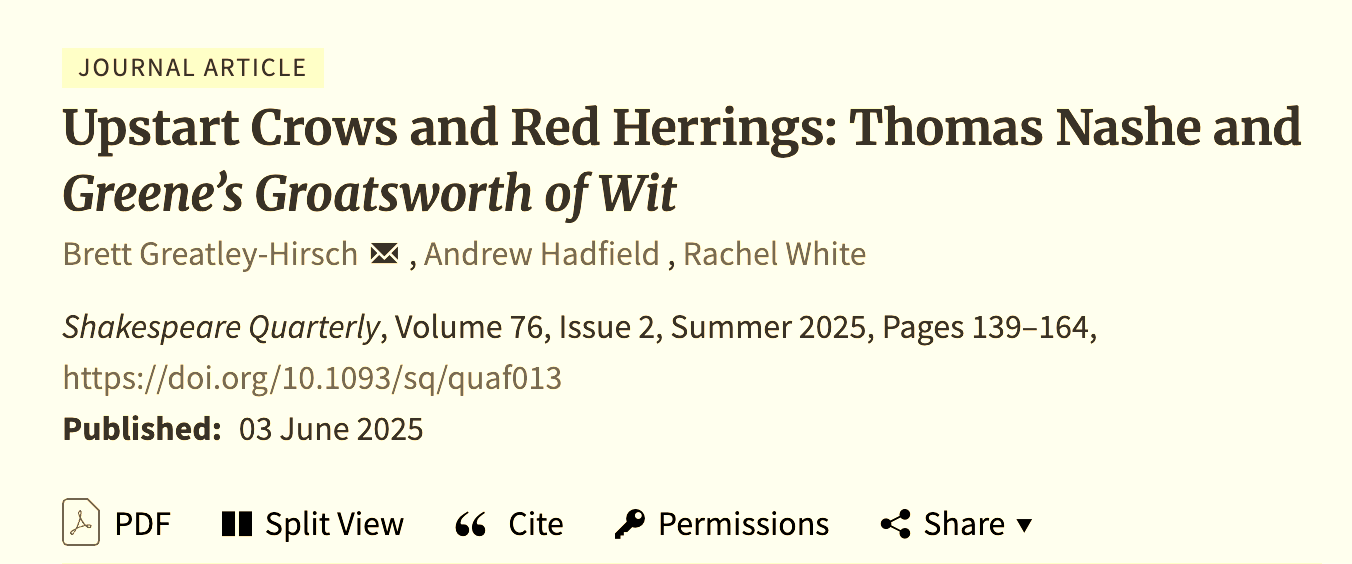Debunking the Thomas Nashe 'Upstart Crow' Computer Analysis
Why Stylometry Fails Shakespeare Studies
Yes, there is still a Hand D post that is due. Yes, my next post was due to address, in a little more depth, this “Nashe was Oxford” nonsense. And yes, I’ve been quiet here longer than I would like, and the exciting paper I’m co-authoring with a subscriber to AAQ is not yet complete.
I’ll be frank: I am juggling too many plates. In my quest to secure replacement income, post-redundancy, I’m wearing umpteen hats. Piecemeal work and task-switching take their toll. Currently, I am working on no less than a dozen different fronts, including mentoring some UCL students through their Marketing dissertations. Weekends aren’t restful, due to DIY duties, and my health is also, at times, causing me grief.
However, I feel compelled to jump in, while it is still making the Google Alerts, on the latest Stratfordian nonsense making the news. And here it is: a claim that computer analysis makes Thomas Nashe the man who accused William Shakespeare of being “the Upstart Crow.”
In one sense, this is not a new claim. Nashe was accused of writing “Greene’s Groatsworth of Wit”, where that phrase appears, shortly after it was published in 1592. He defended himself against the rumours in the preface of the second edition of Pierce Penniless. All of this history is well-known and covered in the body of the essay, which is written by my PhD supervisor, Professor Andrew Hadfield. He has become, of late, something of an authority on Nashe, having previously focused on Edmund Spenser, and then Shakespeare as a Republican. Although I can confirm from my conversations with him from 2006 to 2010, he has always been extremely interested in Nashe.
It covers the history of doubts about authorship of Groatsworth, Nashe’s history of anonymous pamphleteering, the overlapping styles of Nashe and Greene (Greene’s being easily copied; Nashe’s skills making him so flexible an imitator that his hand in Marlowe’s Dido isn’t possible to detect). I will say on that latter front that we know (surely, by now) that names on title pages don’t necessarily convey authorship (A Yorkshire Tragedy, and the London Prodigal, anyone?) and other scholars argue Nashe’s name on Dido may not mean any more than an editorial hand, a tidying in bringing it to press.
Hadfield is following the lead of Katherine Duncan-Jones, who suggested Nashe as the author of the Groatsworth Epistle after concluding it couldn’t be Henry Chettle. The academic consensus (which lasted for some decades) that it was by Chettle (the publisher of Groatsworth) was based on a flawed (very early) study in computational stylistics (Warren B Austin, 1969) which was authoritatively endorsed by the editor of the 1994 Groatsworth edition, D Allen Carroll. But this study was comprehensively overturned by Richard Westley in 2006. Rather than return to the possibility that Greene is the author (as Chettle stated), Duncan-Jones suggested Nashe, saying, “A memorably brilliant piece of writing —glancing, allusive, learned, and double-edged in a manner beyond the reach of the journeyman Chettle.” They may not be Chettle’s qualities, but they are certainly Robert Greene’s.
Why is there so much difficulty accepting that Groatsworth is really written by Greene? Especially when one considers his circumstances (dying in penury) and the letter’s obsession with money?
One could spend some time untangling reasons and motivations. Is it because orthodox scholarship has the wrong person pegged as the Upstart Crow in the first place, and Greene attacking Shakespeare makes no sense? Is it simply that one must, to keep a Shakespearean academic career alive, continue to find fresh angles, by turning over the sod in a field that has been so thoroughly overworked that it’s barren? Building falsehood on falsehood to prop up the magnificent castle of Shakespeare that teeters so dangerously on its shallow and undermined foundations? Whatever the reasons, Hadfield finds Duncan-Jones’ arguments for Nashe as author “compelling”.
Nashe’s supposed motivation is alarmingly weak: Shakespeare messed about with Nashe’s contribution to a multi-handed text, Henry VI Part 1. Allegedly. The evidence from the next several years that Nashe and the author known as Shakespeare are surprisingly close is completely ignored. But that doesn’t matter. Because COMPUTERS.
Yes, Hadfield’s essay (the first 16 of 26 pages) is skilfully written, and I have no objection at all to the arguments it forwards, even if I disagree with his conclusions, which are based on a series of misunderstandings one can hardly avoid if you have a Stratfordian viewpoint.
What I do object to is the ten-page Appendix by Brett Greatley-Hirsch: the superficial report of the results of stylometric tests. Hadfield’s essay is standard Eng Lit fare that any knowledgeable scholar can easily address. It is this faux-scientific Appendix which gives the Nashe attribution of the Groatsworth letter the air of inarguable authority that has brought this claim to the attention of the mainstream press.
I say superficial because this is not a deep dive. The publication, after all, is Shakespeare Quarterly, not Digital Scholarship in the Humanities. Probably the most authoritative of all Shakespeare journals (a danger in itself, given the poor research that follows), its readership can be more or less guaranteed not to have any scientific or mathematical foundation: the use of advanced computational techniques will be enough in itself to impress and persuade. But because this is the journal, there is no revealing of methods or tables of data. There is nothing here one could play with to replicate.
But it’s fine. Because if you have a proper and critical grounding in the discipline, you can see very quickly what is wrong with these claims. The foundational problems of computational methods when applied to Early Modern texts have repeatedly beenaddressed: by Joseph Rudman (1997, 2010), Walter Daelemans (2013), Patrick Juola (2016). Two of the methods used: Burrow’s Delta, a variation on Craig’s Zeta, are the modern Shakespearean’s smoke and mirrors, largely responsible for the New Oxford Shakespeare’s co-authorship claims.
Don’t misunderstand me; I’m not against the idea that there are multiple hands in the Shakespeare canon. But computational methods, to be effective, require reliably sole-authored (and standardised spelling) texts, strict genre and time boundaries, and enormous datasets (as well as proper controls, and data training). They are hugely unreliable when applied to (small) Early Modern datasets, especially drama, where the “voice” is not the authors, but multiple characters.
Numerous papers on the issues with Zeta and Delta have been published by myself (2019, 2021) and more significantly and damningly, by the mathematician Pervez Rizvi (2018, 2019). David Auerbach, another critic, said in 2018 of Rizvi’s demolition, “Pervez Rizvi has written an extensive critique of the Zeta approach and so I pass over that method here.” Greatley-Hirsch’s work was a particular focus of Rizvi’s scrutiny. And yet, here he is, using Zeta again, in Shakespeare Quarterly.
The third method used is a new one to me, and new to Early Modern authorship attribution as far as I can tell. SVMs (Support Vector Machines) are — from even a cursory enquiry as to their normal uses — a misappropriated method from an unrelated field, and totally unsuited to the job at hand.
To work effectively, they need massive datasets; even larger than those required for Zeta and Delta (which don’t exist for the authors being tested in this study).
The research shows they consistently underperform compared to other methods, and they suffer from the same fundamental problems as other machine learning approaches when applied to high-dimensional, small-sample stylometric data.
Recent studies attempting to use SVMs for stylometric problems acknowledge their inadequacy, evidenced by "overall poor performance" and "yield lower accuracies."
In short, this is more “blind them with science” nonsense from an industry desperate to shore up the breaches of its defences with what readers, in their ignorance of the methods themselves, find inherently authoritative and persuasive.
Below the paywall, the deep dive for my paid subscribers describes in greater detail the limitations of all three methods and why computers (yes, including AI) will not solve the Shakespeare Authorship Question.
Keep reading with a 7-day free trial
Subscribe to Adventures in the Authorship Question to keep reading this post and get 7 days of free access to the full post archives.





